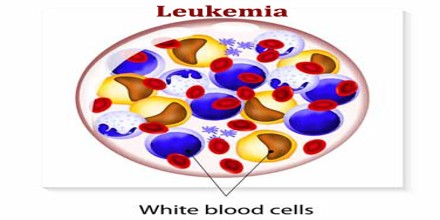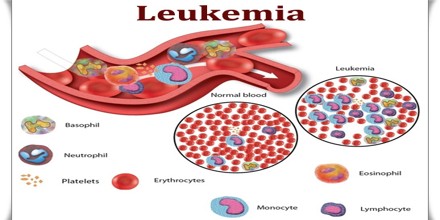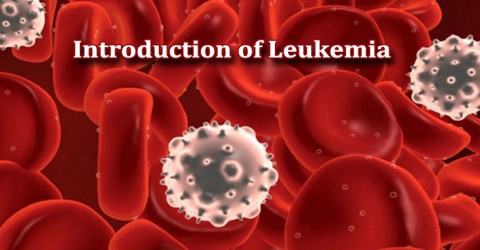Introduction of Leukemia
Leukemia is cancer of the blood causing too many white blood cells to be produced and affecting the bone marrow. Leukemia involves the production of abnormal white blood cells — the cells responsible for fighting infection. However, the abnormal cells in leukemia do not function in the same way as normal white blood cells. The leukemia cells continue to grow and divide, eventually crowding out the normal blood cells. The end result is that it becomes difficult for the body to fight infections, control bleeding, and transport oxygen.

Different types of leukemia depend on the type of blood cell that becomes cancer. For example, lymphoblastic leukemia is a cancer of the lymphoblasts (white blood cells, which fight infection). White blood cells are the most common type of blood cell to become cancer. But red blood cells and platelets may also become cancer.
Leukemia occurs most often in adults older than 55 years, but it is also the most common cancer in children younger than 15 years.
Types and Causes of Leukemia
Leukemia is also classified according to the type of cell. Leukemia involving myeloid cells is called myelogenous leukemia. Myeloid cells are immature blood cells that would normally become granulocytes or monocytes. Leukemia involving lymphocytes is called lymphocytic leukemia. There are four main types of leukemia:

Acute Myelogenous Leukemia (AML): Acute myelogenous leukemia (AML) can occur in children and adults. According to National Cancer Institute (NCI), about 21,000 new cases of AML are diagnosed annually in the United States. This is the most common form of leukemia.
Acute Lymphocytic Leukemia (ALL): Acute lymphocytic leukemia (ALL) occurs mostly in children. About 6,000 new cases of ALL are diagnosed annually.
Chronic Myelogenous Leukemia (CML): Chronic myelogenous leukemia (CML) affects mostly adults. About 7,000 new cases of CML are diagnosed annually.
Chronic Lymphocytic Leukemia (CLL): Chronic lymphocytic leukemia (CLL) is most likely to affect people over the age of 55. It’s very rarely seen in children. About 15,000 new cases of CLL are diagnosed annually. Hairy cell leukemia is a very rare subtype of CLL. Its name comes from the appearance of the cancerous lymphocytes under a microscope.
Chronic Myelomonocytic Leukemia (CMML): Chronic myelomonocytic leukemia (CMML) is another type of chronic leukemia that develops from myeloid cells.

The causes of leukaemia aren’t known. Some risk factors appear to influence its development. Cases of leukaemia are classified as acute or chronic. Cancer cells in acute leukaemias start multiplying before they develop beyond their immature stage.
Chronic leukaemias progress more slowly, with cancer cells developing to full maturity. Leukaemias are further classified according to the type of white blood cell involved. Under a microscope, two main types of white blood cells are easily distinguishable: Myeloid cells contain tiny particles or granules; lymphoid cells usually do not.
Most cases of leukemia are not believed to be hereditary, but certain genetic mutations and conditions can be passed along to offspring that increase the chances of developing leukemia. A condition known as Li-Fraumeni syndrome is characterized by an inherited mutation in a tumor suppressor gene known as TP53, and individuals with this condition have an increased risk of leukemia and other cancers. Other hereditary conditions that can increase the risk of developing leukemia include Down syndrome, neurofibromatosis type1, ataxia telangiectasia, and Noonan syndrome. The risk of leukaemia is increased for people whose jobs involve working with the chemicals benzene and formaldehyde and those who work in the rubber industry.
Symptoms & Treatment of Leukemia
The symptoms of leukemia include:

- excessive sweating, especially at night (called “night sweats”)
- fatigue and weakness that don’t go away with rest
- unintentional weight loss
- bone pain and tenderness
- painless, swollen lymph nodes (especially in the neck and armpits)
- enlargement of the liver or spleen
- red spots on the skin, called petechiae
- bleeding and bruising easily
- fever or chills
- frequent infections
Leukemia can also cause symptoms in organs that have been infiltrated or affected by the cancer cells. For example, if the cancer spreads to the central nervous system, it can cause headaches, nausea and vomiting, confusion, loss of muscle control, and seizures.

In addition to a medical history (asking about symptoms and risk factors) and a physical exam to look for signs of leukemia (lymph node enlargement, enlargement of spleen), the diagnosis of leukemia typically involves laboratory studies of a blood sample. A sample of the bone marrow may also be obtained to establish the diagnosis.
Cells from the blood and bone marrow are further tested if leukemia cells are present. These additional tests look for genetic alterations and expression of certain cell surface markers by the cancer cells (immunophenotyping). The results of these tests are used to help determine the precise classification of the leukemia and to decide on optimal treatment.
A number of other tests can be run to assess the progression of the disease, including:
- Flow cytometry examines the DNA of the cancer cells and determines their growth rate.
- Liver function tests show whether leukemia cells are affecting or invading the liver.
- Lumbar puncture is performed by inserting a thin needle between the vertebrae of your lower back. This allows your doctor to collect spinal fluid and determine if cancer has spread to the central nervous system.
- Imaging studies, such as X-rays, ultrasounds, and CT scans, help doctors look for any damage to other organs that’s caused by the leukemia.
The treatment depends on the type and stage of the cancer. Some forms of leukemia grow slowly and don’t need immediate treatment. However, treatment for leukemia usually involves one or more of the following:
Chemotherapy uses drugs to kill leukemia cells. Depending on the type of leukemia, you may take either a single drug or a combination of different drugs.
Radiation therapy uses high-energy radiation to damage leukemia cells and inhibit their growth. Radiation can be applied to a specific area or to your entire body.

Stem cell transplantation replaces diseased bone marrow with healthy bone marrow, either your own (autologous transplantation) or from a donor (allologous transplantation). This procedure is also called a bone marrow transplant. There are a number of types of Stem Cell transplantations: Bone Marrow Transplantation, Peripheral Stem Cell Transplantation, Umbilical Cord Blood Transplantation, Allogeneic Stem Cell Transplantation, Syngeneic Stem Cell Transplantation.
Biological or immune therapy uses treatments that help your immune system recognize and attack cancer cells.
Targeted therapy uses medications that take advantage of vulnerabilities in cancer cells. For example, imatinib (Gleevec) is a targeted drug that is commonly used against CML.
Side-Effects of Leukemia Treatment
Treatment for Leukemia can damage healthy tissues and cells in persons with the disease, producing undesired side-effects. The side-effects a person will experience depend on a number of different factors that are based on the individual. The side-effects a person experiences may change from one treatment session to the next as well.
















